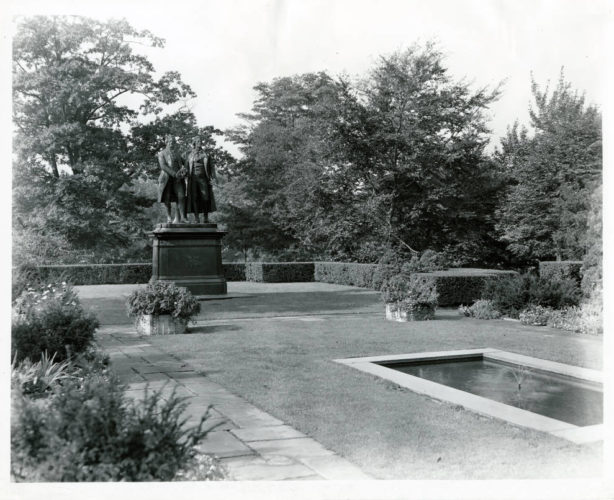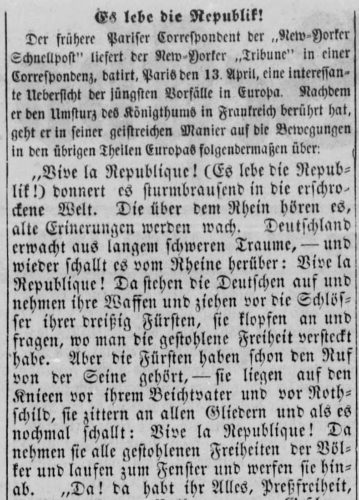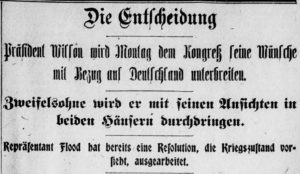From Deutschland to Ohio: German-American Newspapers

Since 2012, the Ohio History Connection has digitized nearly 15,000 pages from two of Ohio’s German-American newspapers: the Tägliches Cincinnatier Volksblatt (“People’s Daily Journal”), 1914-1918 (available on Chronicling America), and the Columbus Westbote (“Western Messenger”), 1843-1862 (available on Ohio Memory). With additional funding through the National Digital Newspaper Program, we will be adding another 50,000 pages of Ohio’s German-American newspapers to Chronicling America over the next year. These will document German immigrant communities in Canton, Cincinnati, Cleveland, Columbus, New Philadelphia and Pomeroy from the 1830s through the 1950s.

Germans were among the first immigrant groups to arrive in Ohio, and they established communities, churches and newspapers across the state. Many settled on the Ohio River, in Cincinnati, but communities of Germans were also found in the urban centers of Cleveland, Columbus and Toledo, as well as smaller cities and towns such as Delphos, Newark, New Philadelphia and Portsmouth. For many years, they were the most populous immigrant group in Ohio, and by 1910, made up half of Cincinnati’s population.
Germans opened breweries, operated farms and started factories, including Ferdinand Schumacher’s Quaker Oats. To support craftsmen and artisans, they established mutual aid societies, or labor organizations, and were active in their communities’ local politics. Although Germans continued to immigrate to the U.S. throughout the late 19th and early 20th century, most had arrived by the mid-19th century and were well-established by the time of the Second Industrial Revolution (1870-1914).
For immigrant communities like German-Americans, newspapers published in their own language were particularly important. Ohio was a stronghold for German-American newspapers prior to World War I, and their influence often reached well beyond city and state boundaries: the Cincinnati Volksblatt was the first German daily to be published in the U.S., and the Columbus Westbote was often referred to as the “Democratic Bible.” New immigrants looked to these publications as a way to bridge the gap between their old and new homes, by keeping connected to their countries of origin and learning about their new country through news reports.

Not only were German-American newspapers an important tool of Americanization, but they captured a segment of history that is often given less attention than mainstream history, providing insight into German-American people and their daily lives, business, politics, opinions and more, in their own words. With decreased immigration, anti-German sentiment during World War I, Prohibition and increased Americanization of future generations, however, the German-American press declined in the 20th century and relatively few newspapers remain today.
Most German-American newspapers were published primarily in German language, although more English content appeared the longer a newspaper survived. Because of this, if you are performing a keyword search in one of these digital newspapers, your search term will need to be in German too. Dictionaries and online translation tools can help you translate your English term to German if you don’t speak German, but you’ll also need to become familiar with reading German in Fraktur. German-American newspapers often used this font, and because so many letters look similar, it can be difficult to read and translate these materials.

To help you overcome this challenge, we have released a YouTube video, Working with German Fraktur, which will walk you through what Fraktur is and how to get the German-language newspaper article you found translated into English. The tips shared in this video will also be helpful for other German-language printed materials.
Ohio is not the only state to have digitized German-American newspapers–visit Chronicling America to see more content covering this important immigrant group. We’ll be digitizing selections from other foreign language newspapers published in Ohio for Chronicling America over the next year as well. If you’re interested in learning more about this project, including the full selection list and updates for when new content is available online, please visit the National Digital Newspaper Program in Ohio Project Website.
Thanks to Jenni Salamon, Coordinator for the Ohio Digital Newspaper Program, for this week’s post!



Leave a Reply
You must be logged in to post a comment.